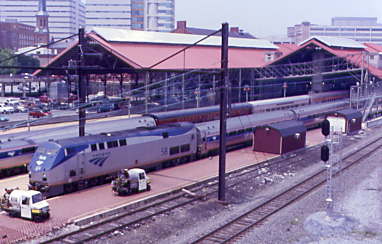
At last year's NRHS convention in Arizona, I signed up for this year's convention and received the three events I was interested in, namely Baltimore Transit Tour, the Harrisburg Circle and the Blue Mountain Limited. I wanted to fly in late at night but there were no flights so used my Alaska Airline miles but the only seats left on that day was first class so I would experience that as well. The convention hotel was already sold out and I did not feel like paying $135 or more a night for a room. My AAA book for this region found me the Best Inn-Moravia east of Baltimore in the low $60 range. I contacted the Maryland Transit Agency, who planned my light rail and bus trips from the airport to the hotel and return, as well as my routing to the convention activities. With all that set in early May, I lived my life, rode trains as usual and could not wait to get some new eastern rail mileage.
7/2/2003 I was up early at 4:30 AM to pack my bags for the 7:10 AM flight to St. Louis, drove the van to John Wayne Airport and said goodbye to my mother before entering and it was the busiest I had ever seen it. The American Airlines ticketing line was at least a hundred deep and the First Class Line had fifteen people in it. It took fifteen minutes to reach the counter and less than two to get my boarding pass. The reason I did not get it online was because I had to exchange the Alaska Airlines tickets they sent me for those of American Airlines. The security checkpoint was ten minutes in the First Class line versus the regular line, which stretched out of sight through the south terminal door. I had no problems with security this time and was seated at the gate by 6:25 AM.
American Airlines Flight 2858 7/02/2003Boarding the 757 jet into First Class was an enjoyable experience as I had seat 2F and the coach passengers and baggage took their time, so we left the gate ten minutes late. I had pancakes and a Coca-Cola for breakfast, not the ideal combination. There were beautiful views of the Salton Sea and in-flight film was "How to Lose a Guy in Ten Days", which took me from the Colorado River to eastern Kansas. We looped into Illinois before arriving in St. Louis, where I had less than fifty minutes until my flight to Baltimore but walked from Gate C16 to C2 in less than two.
American Airlines Flight 2902 7/02/2003
This plane was a Super 80 model and we left the gate on time, but were sixth in line for takeoff and it started to rain, which was my first rainy takeoff. We flew over scattered clouds as far as Louisville, Kentucky, before flying over the top of the leftover moisture of Tropical Storm Bill that hit Louisiana last weekend. We landed in the rain and I walked off the plane through BWI Airport to the light rail station.
Baltimore Light Rail 7/02/2003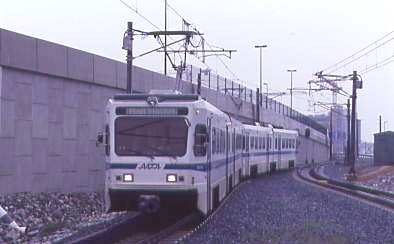
The ticketing machine would not sell me a weekly pass as they do not go on sale until Thursday, but are not valid until Sunday. I just missed a train and had to wait ten minutes for the next one. The route started with a brief section of curving single track before it became double track again. We left the airport after the Ferndale stop and entered the forest where we joined the line from Glen Burnie then stopped at Linthicum Station followed by North Linthicum and Nursery Road, crossed the Patapsco River then stopped at Baltimore Highlands and Patapsco Station. We went under a CSX line as we made our way to Cherry Hill, which is located along the CSX line to the harbour, then passed waterfront industries as we made our way to Westport.
The middle branch of Baltimore Harbour came into view as the line became single track again to cross another branch of the harbour. The Baltimore Ravens Stadium, followed by Camden Yards, home of the Baltimore Orioles, came into view to the west and we reverted to double track once more. We stopped at the Camden Yards station as a MARC train was waiting to go to the storage yard. The LRV ran into downtown with a stop at the Convention Center before I detrained at University Center.
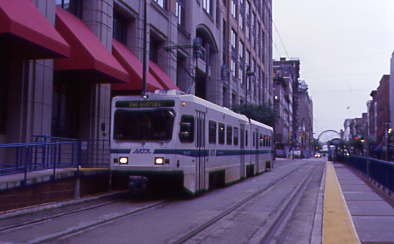
I walked over to the Wyndham Hotel, the convention hotel, to check in and pick up my tickets and convention goodies. Out into the rain, I went to Charles Street where I caught the 3 bus to Loch Raven and Belvedere, where along with some other locals, we waited for the late 44 bus that took me to the end of Frankford to the Best Inn-Moravia. I checked in for a five-night stay then called Vizzini's for an order of chicken wings, fries and garlic bread then looked over the convention materials before I called it a night.
Baltimore Light Rail 7/03/2003
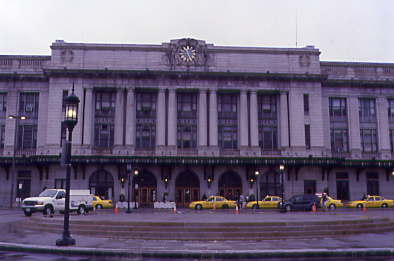
I woke with the alarm, showered and dressed before walking out to the 44 bus stop. It was still wet but at least it was not raining. The connection to the 3 bus worked out really well and I debussed at Penn Station, stopping at the news stand before walking downstairs to the closest platform, Track 1, to catch the light rail train with a MARC bi-level train on Track 2, both of which were built by ABB Traction. We proceeded south along the leads to the station before climbing a hill and crossing a bridge to join the mainline from Hunt Valley before the University of Baltimore/Mount Royal station. We next passed the old Baltimore and Ohio Mount Royal station, complete with its train sheds and active CSX mainline to Philadelphia. Now back in downtown, we ran on the side shoulder of streets to the Cultural Center, Center Street, Lexington Market and back to the University Center stop where I had detrained late yesterday afternoon.
Trains from Penn Station run to the Airport and those from Hunt Valley run to Glen Burnie. As such, I had now ridden the whole airport line. I walked to McDonald's for a breakfast of hot cakes and sausage before walking four blocks to the MARC station at Camden Yards.
MARC Train 851 Camden Line 7/03/2003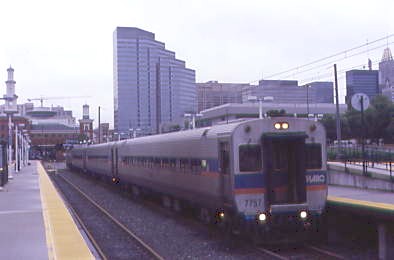
The train arrived from Washington, DC with GP40WH-2 57, coaches 7772 and 7794 and cab car 7757; the passenger cars were built by Nippon-Sharyo of Japan in 1991. This journey would be new mileage as far as Dorsey since Amtrak's short- lived Night Owl was so late arriving on August 18, 2000 that I only reached Dorsey before turning back to DC. We left with the Howard Tunnel line joining ours as we passed the Baltimore Ravens stadium before my train, and a CSX train exiting the tunnel, stopped due to inbound MARC Train 402. We proceeded out of Baltimore through an old industrial area before going under Interstate 95 and another CSX freight was passed before Carol then we passed a line of cabooses of CSX and pre-CSX railroads, which looked like a museum.
We then crossed over the Northeast Corridor followed by speeding through the flag stop at St. Denis, traversed the historic Thomas Viaduct over the Patapsco River, which was designed by Benjamin H. Latrobe II and completed in 1835. At that time, it was the largest stone bridge in the United States, as well as the first masonry bridge built on a curved alignment. There are obelisk monuments commemorating the viaduct. About six minutes later, we arrived at Dorsey, ending my new mileage. All I then had to do was to sit back and relax to Washington Union Station, at which we arrived on time.
Washington, DC 7/03/2003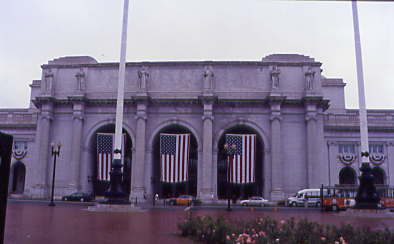
Washington Union Station is Amtrak's second-busiest station and the country's 10th-busiest railroad station. The station is the southern terminus of the Northeast Corridor, an electrified rail line extending north through major cities including Baltimore, Philadelphia, New York City, and Boston and the busiest passenger rail line in the nation.
Designed by Daniel Burnham and assisted by Pierce Anderson, it was inspired by a number of architectural styles. Classical elements included the Arch of Constantine (exterior, main façade) and the great vaulted spaces of the Baths of Diocletian (interior); prominent siting at the intersection of two of Pierre (Peter) Charles L'Enfant's avenues, with an orientation that faced the United States Capitol just five blocks away; a massive scale, including a façade stretching more than 600 feet and a waiting room ceiling 96 feet above the floor; stone inscriptions and allegorical sculpture in the Beaux-Arts style; expensive materials such as marble, gold leaf and white granite from a previously unused quarry.
In the Attic block, above the main cornice of the central block, stand six colossal statues (modeled on the Dacian prisoners of the Arch of Constantine) created by Louis St. Gaudens. These are entitled "The Progress of Railroading" and their iconography expresses the confident enthusiasm of the American Renaissance movement: Prometheus (for Fire), Thales (for Electricity), Themis (for Freedom and Justice), Apollo (for Imagination and Inspiration), Ceres (for Agriculture) and Archimedes (for Mechanics).
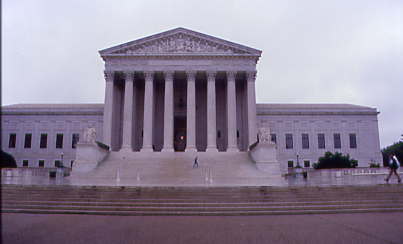
The Supreme Court Building houses the Supreme Court of the United States, the highest court in the federal judiciary of the United States. The building serves as the official workplace of the chief justice of the United States and the eight associate justices of the Supreme Court. Designed in the neoclassical style, the proposal for a separate building for the Supreme Court was suggested in 1912 by President William Howard Taft, who became Chief Justice in 1921. In 1929, Taft successfully argued for the creation of the new building but did not live to see it built. Physical construction began in 1932 and was officially completed in 1935 under the guidance of Chief Justice Charles Evans Hughes, Taft's successor. The building was designed by architect Cass Gilbert, a friend of Taft.
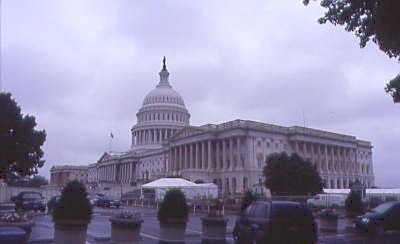
It was still trying to rain and with more expected, as well as my body still being on Pacific Daylight Time, I decided to forgoe the National Capitol Trolley Museum for another time but walked over to the US Capitol Building, where a new visitor's centre was being constructed in front of the Capitol, which made photography difficult since there a high wall.
I returned to Union Station and remembered on my Amtrak Guest Rewards card that it had Club Acela stamped on it, so toured the very nice lounge, then walked out to Track 10 to board a MARC train back to Penn Station in Baltimore.
MARC Train 414 Penn Line 7/03/2003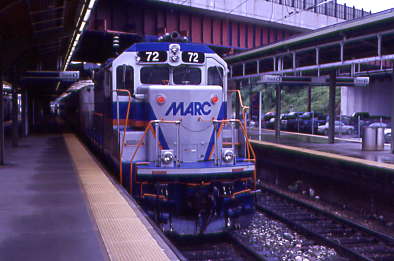
This train had GP40H-2 75, coaches 7726 and 7725 followed by cab car 7756. I sat back and relaxed as this is a route I have covered in a variety of equipment: today's low-level cars and the bi-level cars during my visit to Maine on January 2nd 2002; the on Amtrak, Amfleet I and II's, 10-6 sleepers, a Viewliner sleeper, Metroclub, Acela Business and Acela First Class cars, as well as the occasional diners and lounge cars. The neat thing about riding MARC is that since one is sitting on a seat covered with sixteen little "MARC" emblems, you are truly riding MARC.
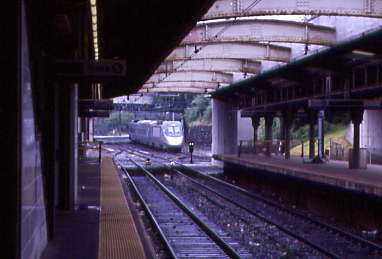
While I was photographing my train, the Acela Express arrived from points north. I caught an 11 bus by mistake out to Northern Parkway, to connect with the 44 bus, which allowed me to see an affluent area of the city but had to wait forty-four minutes for the 44 bus, which returned me to my room by 1:00 PM and I planned to just to relax the rest of the day. Off in the distance was some golden arches so I walked to McDonald's for an early dinner.
7/4/2003 The day started rough as I first cut myself shaving, then left my watch in the room when I went to the bus stop so returned to retrieve it and ended up leaving the room keys in the room as well. Minor rocks on the road of life, but as I always say, "Everything works out if you let it!" The 44 bus arrived and took me to Loch Haven, where I waited for the 3 bus to take me to downtown then disembarked at Fayette Street and went to McDonald's for my usual breakfast prior to going to the Liberty Street side of the Wyndham Hotel to wait for the bus to the Transit Tour.
NRHS Convention Baltimore Transit Tour 7/04/2003We departed at 9:00 AM on the way to the Metro Subway shops for an intensive tour of their facility.
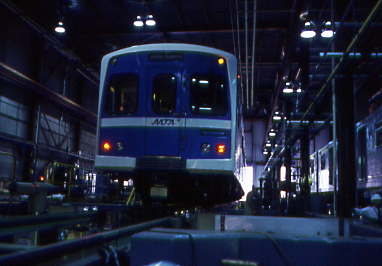
One of the Universal Transit Vehicles in the shop.

Cars with their trucks off and over the work pits having all sorts of work performed.
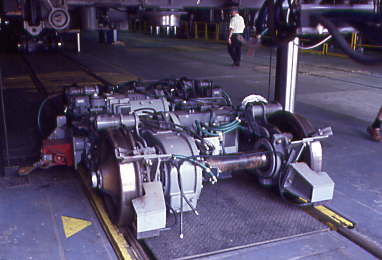
We saw the machine, electrical and motor shops and were allowed to tour two cars, an original model and one which had been completely rebuilt. These cars were the last cars built by the Budd Company. It was a fascinating experience after all my trips on heavy rail systems and I finally was able tp see one of their shop buildings and learn how the cars are maintained. After learning all about the Metro Subway, the bus took us out to the Owings Mills Metro station for a ride on the complete system.
Baltimore Metro Subway 7/04/2003The origins of the Metro SubwayLink lie in the Baltimore Area Mass Transportation Plan published in 1965, which envisioned six rapid transit lines radiating out from a central city loop. Planning studies from 1968 proposed a rail transit system 71 miles long. As the vision was translated into reality, the original concept was trimmed to a 28 mile system in the Phase 1 plan, published in 1971. This plan involved two of the original six lines: a northwest line from Downtown Baltimore to Owings Mills and a south line to Glen Burnie and the airport. Phase 1 was approved for funding by the Maryland General Assembly in 1972. In response to lobbying by Anne Arundel County residents, the MTA eliminated the south line from Phase 1 plans in 1975; the Baltimore Light RailLink was later built over much of the planned south line corridor.
When the Metro SubwayLink opened on November 21, 1983, only the "Northwest" line of the 1965 plan had come to fruition. This 7.6 mi segment provided service between Charles Center in Downtown Baltimore and the Reisterstown Plaza shopping center in the northwest of the city. On July 20, 1987, a 6.1 mile addition extended the line from Reisterstown Plaza to Owings Mills in Baltimore County, with a portion running in the median of Interstate 795. A further extension of 1.6 miles from Charles Center to Johns Hopkins Hospital opened on May 31, 1995. Once the project was completed in 1995, the total cost for the Metro SubwayLink stood at $1.392 billion.
The current system is 15.4 miles, consisting of 6.2 miles underground, 2.2 miles elevated and 7 miles at grade. Eight of its 14 stations are underground, at depths from 52 feet to 112 feet below street level. Its elevated stations stand from 25 feet to 28 feet above ground. When the system opened, it became the largest single user of Susan B. Anthony dollar coins in the United States.
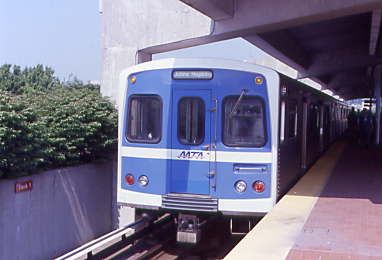
After taking a picture of our train, I boarded the first car to start my new mileage and we took off, running in the middle of the Interstate 795, with the former Western Maryland CSX line that I would be riding on Sunday off to the right. We ran to Old Court, where we switched to the Interstate 695 median before leaving the freeway for a private right-of-way then proceeded down the valley with the green hills of Maryland on both sides to Milford Mill, Reisterstown Plaza and Rogers Avenue. We passed the Metro shops then stopped at the West Cold Spring Station and descended underground for the rest of our trip into Baltimore.
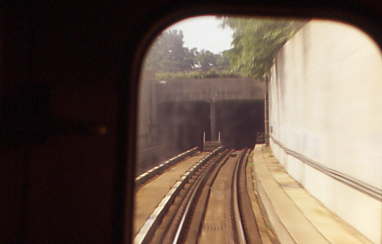
We stopped at Mondawmin, Penn-North, Upton/Avenue Market, State Center, Lexington Market, Charles Center, Shot Tower/Market Place and the last stop at Johns Hopkins Hospital, where we detrained and went up to the surface to see the towers on top of the original Johns Hopkins Building.
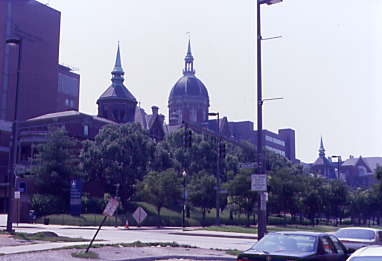
Each of the towers is unique in their own right; the building was completed in 1899 and is in the Queen Anne architecture style.
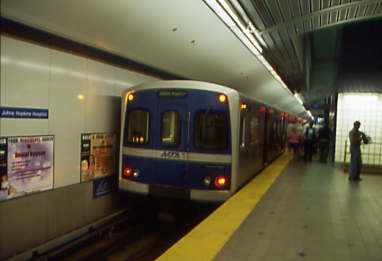
We returned to Owings Mills and I rode in the front of the car then we were bussed back into town to the Baltimore Streetcar Museum.
Baltimore Street Car Museum 7/4/2003The Baltimore Streetcar Museum is a non-profit museum located at 1901 Falls Road (MD 25) in Baltimore, Maryland. The museum is dedicated to preserving Baltimore's public transportation history, especially the streetcar era. The museum is open Noon to 5 P.M. every Sunday March through December and Noon to 5 P.M. Saturdays, June through October.
The original Museum collection had been under the stewardship of the United Railways and Electric Company, then the Baltimore Transit Company and finally, for a short time, the Maryland Historical Society. Finally the Baltimore Streetcar Museum was founded in 1966 by several members of the Baltimore Chapter of the National Railroad Historical Society. The collection was moved from Robert E. Lee Park near Lake Roland in 1968 to the present Falls Road Maryland and Pennsylvania Railroad site and public operations began in July 1970. Before public operations could commence, many hours of volunteer work were necessary to build operating track and install overhead wire which, at first, provided only a short ride for visitors. Over the years, the Museum has incrementally extended its line along Falls Road that includes now turning loops at the north and south ends of its line. Completion of the Museum's entire streetcar line was realized in October 2008 with the completion of its double tracking project, which took many years to complete. The track gauge is 5 feet 4 1/2 inches, which is unique.
The Baltimore Streetcar Museum houses the library collections of the Baltimore Streetcar Museum and the National Railway Historical Society (Baltimore Chapter), formally known as Maryland Rail Heritage Library.
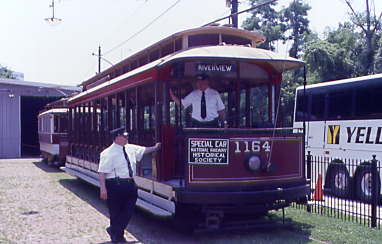
We arrived and while half of our group went inside to eat, I decided to ride Baltimore Streetcar Museum open bench streetcar 1164, ex. Maryland Historical Society 1164 1954-1968, exx. Baltimore Transit 1164 1935-1954, exxx. United Railways and Electric 1164 1906-1935, nee United Railways and Electric 2458 1902-1906 built by J.G. Brill in 1902. The track at the museum is former Maryland and Pennsylvania Railroad, or Ma and Pa for short. Leaving the car barn tracks, we went past the station and the North Avenue Loop then went underneath the CSX mainline to Philadelphia and by the George F. Nixon Substation. The crew pointed out where the Glen Avenue Tunnel was behind the trees covering the hillside before we passed the 1890's wheel for the Baltimore cable car system. Our trolley turned right, next passing the former Ma and Pa freight house, now the Elmer H. Packie Jr. Rolling Stock & Shops Department. We then came along to the former Ma and Pa roundhouse, now used by the City of Baltimore's Department of Public Works for salt storage and here, we changed ends and returned to the station.
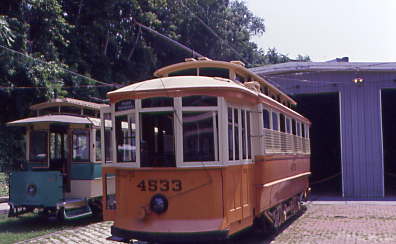
Baltimore Streetcar Museum streetcar 4533 1968-present, ex. National Capitol Trolley Museum 3550 1964-1968, exx. Baltimore Transit 3550 1935-1964, exxx. United Railways and Electric 3550 1933-1935, exxxx. United Railways & Electric 4533 1924-1933, exxxxx. United Railways & Electric 3407 1920-1924, exxxxxx. United Railways & Electric 2306 1914-1920, exxxxxxx. United Railways & Electric 447 1906-1914, nee United Railways & Electric 1306 1904-1906, built by J.G. Brill in 1904.
Other cars on display were Baltimore Traction Company's nine-bench open car 544 built in 1896, Baltimore Consolidated Railway Company's eight window closed streetcar 1050 built in 1898, the 1888-built Baltimore City Railway former horse car 417, United Railway and Electric Co. Peter Witt car 6119 built in 1930, PCC car 7407 built in 1941 and former San Diego PCC car 503 that used to run in El Paso.

After I had my lunch, I rode Baltimore Streetcar Museum PCC car 7407, ex. National Capitol Trolley Museum 7407 1964-1968, nee Baltimore Transit 7407 1944-1964, built by St. Louis Car Company in 1944. This was the last car in service in Baltimore and ran a night-time excursion for the Baltimore Chapter of the National Railway Historical Society on November 3rd, 1963.
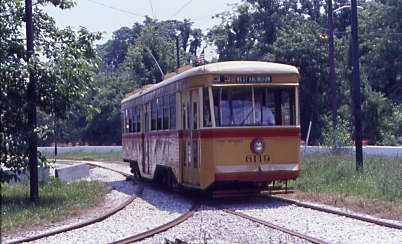
Baltimore Streetcar Museum streetcar 6119, ex. Maryland Historical Society 6119 1955-1968, exx. Baltimore Transit 6119 1935-1955, nee United Railways and Electric 6119 1930-1935 built by J.G. Brill in 1930. This followed us out to the 28th Street Loop where the four of us riding the cars detrained for a photo runby of 6119 on the loop and our car sitting. It was a unique experience to visit this museum but all too soon we had to board the bus to our next stop on our tour.
Baltimore Light Rail Shop Tour 7/4/2003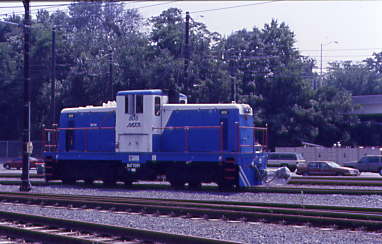
Maryland Department of Transportation 44 ton switcher 1 built by General Electric in the 1940's greeted us as we arrived at the shops, whose system opened from Timonium to Camden Yards for Orioles baseball games on April 3rd, 1992. This was the first light rail shop that I had been in and what an incredible experience I received. If I had to design a light rail shop, I would base it on this design since it is clean and efficient. The overhead crane can replace a car's trucks or the whole carbody in fifteen minutes or less and the module makeup of the LRV makes this all possible. This shop is capable of doing all of its own work and was absolutely spotless inside and out.
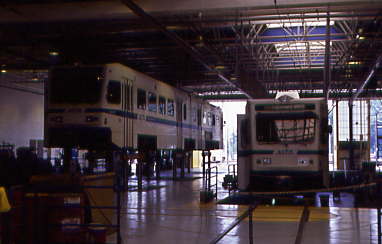
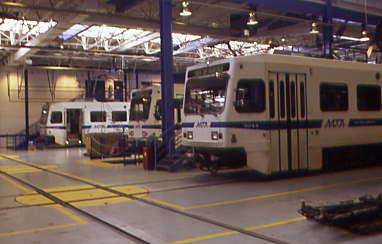
A car up on the lift and several over the pits. I would like to thank the MTA for the excellent shop tours and the Washington, DC Chapter of the NRHS for planning such a spectacular tour of Baltimore's transit system.
Baltimore Light Rail Tour 7/4/2003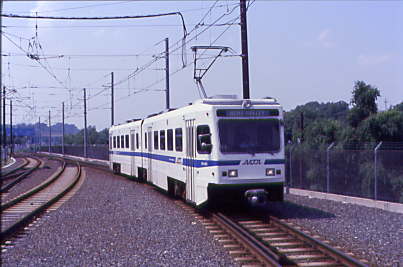
We boarded an originating northbound train at the North Avenue Station for Hunt Valley. The shops were passed before we ran along a stream and under Interstate 695 to Woodberry, where there was a large brick building that was a sail factory for clipper ships and then in the 1950s to 1970s, was a London Fog factory. We ran north below Interstate 695 to Cold Spring Lane then onto Mount Washington and soon after that, Falls Road. We curved through a ravine before crossing Lake Roland then curved and climbed prior to coming to a red signal at the end of double track. Once a southbound train passed, we proceeded to Lutherville and the Timonium Business Park was our next stop before we continued on to Timonium, where there is the last half mile horse track in Maryland.
We waited for another train before sprinting to the next double track segment, then turned at an old wye before stopping at Warren Road, passing the buildings of a light industry to reach Gilroy Road before rounding a tight curve before McCormick Road, followed by a sharp left turn and another tight right turn to Pepper Road. It was then another tight left and right turn to Hunt Valley, the north end of the line. I returned to Baltimore with the train picking up baseball fans for the game I was going to be attending. I would forgo going to the south end of the line at Glen Burnie for another trip when the B&O Museum was reopened after the roof caved in from the heavy snowfall. Once we returned to North Avenue, my new mileage would start again as far as the junction with the line from Penn Station. We went along the CSX line with the Baltimore Streetcar Museum below and crossed over the Northeast Corridor and over to a cut where the CSX line enters Mount Royal station. I rode down to Camden Yards to detrain for the game at 5:05 PM.
Toronto Blue Jays vs the Baltimore Orioles at Camden Yards 7/4/2003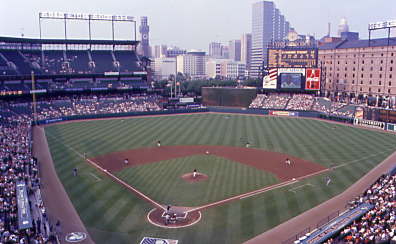
I entered from Utah Street and rode the escalator up to the third deck seat AA3 in section 334 right behind home plate and enjoyed a pair of expensive hot dogs and Coca-Cola. The view behind center field was downtown Baltimore and the warehouses behind right field are the old Baltimore and Ohio buildings. Game temperature was a humid ninety-seven degrees. The game was scoreless into the sixth inning when Eric Hinske hit a grand slam to deep right center to break the game open. The Blue Jays scored five runs in that inning but the Orioles came back in the bottom of the eighth, sending fourteen batters to the plate and scoring eight runs with two outs. It started to rain in the top of the ninth and the ground crew was ready with the tarpaulin just in case. Third baseman Tony Batista made a great diving catch to double the runner off first. What a play it was! The final Blue Jay went down on strikes and I was first down the stairs and out ahead of the crowd then boarded an empty Penn Station-bound train and off we went.
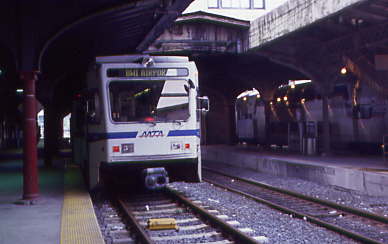
I detrained at Penn Station and was out at the street just as the 3 bus arrived which I boarded then at Belvedere, changed to the 44 bus to take me back to my hotel. This had been the best connections of the whole trip, which took just under an hour.
NRHS Convention Harrisburg Circle 7/5/2003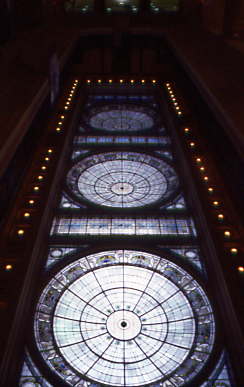
Up at 5:00 AM for the 5:35 44 bus to Loch Raven, then the 3 bus to Penn Station, I arrived while the station was empty and photographed the ceiling then went to the café for breakfast then down to the platform to watch the Federal, formerly the Night Owl, arrive from Boston and depart for Washington.

MARC HHP-8 4910 built by Bombardier-Alstom in 2000. In the concourse I ran into Roy Wojahn and Bill McCracken of our Orange County Railway Historical Society.
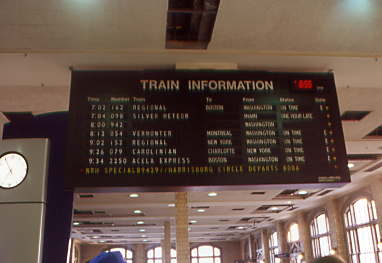
The NRHS Harrisburg Circle trip was posted on the departure board and forty-five minutes later, we were led down onto Platform 7.
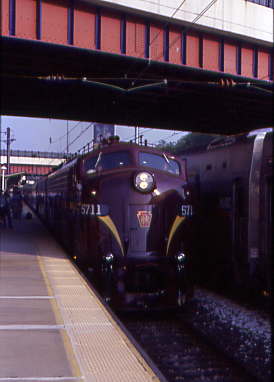
At 8:05 AM, the Pennsylvania Railroad E8s led the train into the station and I boarded an Amfleet business class car and settled in before we departed at 8:19 AM, making our way into Union Tunnel and out by the usual Baltimore row houses. My new mileage would start at Perryville when we turned off the Northeast Corridor to Harrisburg and I relaxed until we reached there. Out in the eastern reaches of Baltimore, we crossed the Middle River then cruised down the corridor through the Gunpow Interlocking, where we crossed the Gunpowder River on the mile-long concrete deck bridge. We then passed MARC Edgewood station and travelled through the forest before crossing Bush River on a half-mile concrete deck bridge with a semi-movable bascule draw span, then sped through Aberdeen and its MARC station. The train slowed through the Oakington Interlocking before the next bridge, which was the center swingspan at Havre de Grace over the Susquehanna River before we reached Perryville.
Here we turned off the Northeast Corridor onto Port Road and took the south wye with the MARC Perryville station in the middle then went under the CSX (former Baltimore and Ohio) line from Baltimore to Philadelphia before reaching the end of double track. I met Saul Wilson, a fifth grader who has his own website about trains and we exchanged business cards. The Susquehanna River was off to the west with a few islands out in its course. This line used to be electrified but the wires were removed, although the catenary support poles remain. We travelled through Rock Siding, Maryland before crossing Octoraro Creek and another arch bridge then reached Pilot siding.
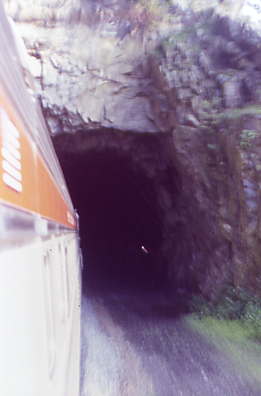
We passed through Wildcat tunnel and minutes later, Frazier tunnel, before entering Pennsylvania.
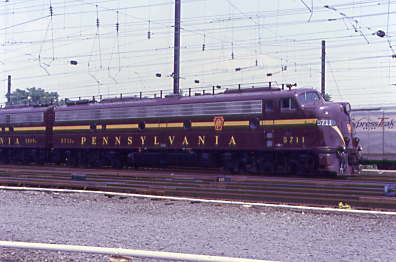
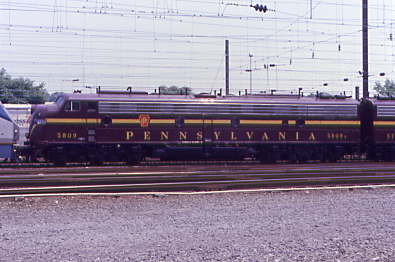
Our consist for this trip was Pennsylvania E8A 5809 and 5711, P-42 DC11, Amcafé, Metroliner coach 20047, Amfleet 44837 and 82078, "Powhatan Arrow", "Clinchfield", "Echo Canyon", "Mohave", "Split Club (Amtrak), "Silver Larch", "Golden Sands", "City of Milwaukee", "Greenwich Harbor", "Warrior Ridge", "Colonial Crafts", "Dover Harbor" and PRR 120.
We passed through Peach Bottom and on the opposite shore of the river was the Peach Bottom Nuclear Power Plant. The river was visible the whole route but mainly through the trees, then the river narrowed and we climbed before passing beneath a highway bridge high above us.

Aldren Dam, which created Lake Aldren stretching for miles behind. Our train passed the slide detector fences on the right before passing House Rock and the Old Bridge curve then reached Peque, home of the world-famous Peque Inn.
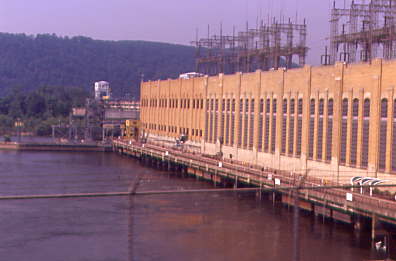
Safe Harbor Dam, which produces electricity for Amtrak's Northeast Corridor.
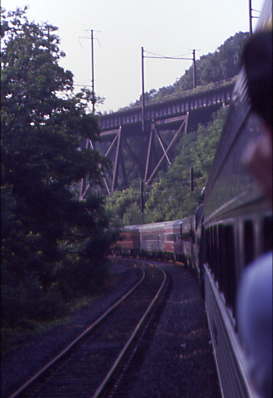

The low grade freight line to Trenton took off and climbed up over the ridge on a spectacular high trestle to our right. From here we ran along the bluffs with three flumes carrying the runoff water over the tracks we travelled. The river opened up with several more islands out in it as we reached Cresswell before Port Road Interlocking, after which we traversed through the village of Washington where we stopped to load the boxed lunches.
We reached Columbia, where the Columbia Secondary joined, which would be our return route from Harrisburg. Behind the fire station was the Reading freight house before we went under the arched highway bridge over the Susquehanna River then crossed Chickies Creek and ran below Chickies Rock prior to going through the town of Marietta. The river valley opened up here, allowing farming down on the floodplain then we turned to the west to cross the Susquehanna River on the Shock Mills bridge, which is 2,221 feet long and was completed in 1905 with 27 piers and 28 arches. Now running north on the west side of the river, we passed through the town of Clay before reaching the community of Goldsboro, where the cooling towers for the Three Island Nuclear Power Plant became visible across the river.
A few miles further, we went under Interstate 76 then by the former New Cumberland Distribution Center and through the town of New Cumberland before ducking underneath the Reading Company concrete multiple-arched bridge, which had a CSX train on it. A few minutes later, the former Pennsylvania Railroad Cumberland Valley Branch crossed the river on another arch bridge.
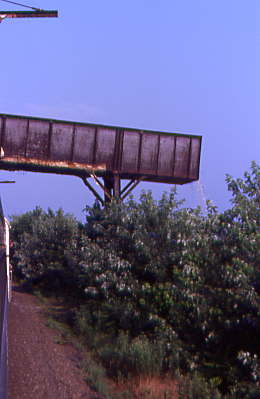
We arrived at Lemoyne and the site of the former Lemo Tower and crossed Conodoguinet Creek before reaching the former site of Day Tower and entering Enola Yard, which was a sad shade of its former glory. We passed the engine facility where I wondered if Conrail had taken over Norfolk Southern, would those black locomotives all have blue patches instead of the Conrail locomotives today having white patches on them. We went under the Interstate 81 bridge before reaching the Iron Bridge that has holes in it for railfanning then arrived at the junction of their line over the Rockville bridge, but had to wait for a westbound Norfolk Southern stack train to clear.
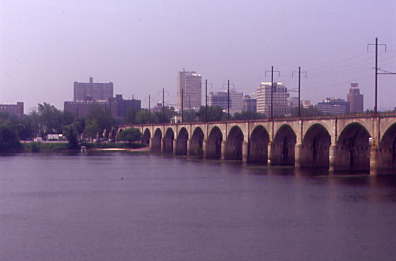
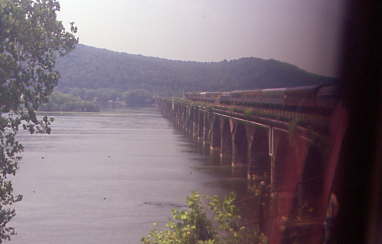
Once out onto the Rockville Bridge my new mileage was at an end as we were back on the Amtrak route into Harrisburg. As we came off this historic bridge, we passed the site of Rockville RJ Tower before stopping to refuel our locomotives then back on the move again, we passed the Harrisburg diesel shops and yards and Harris Tower, which is owned by the Harrisburg Chapter of the NRHS. The State Capitol dome came into view just before we arrived at Harrisburg Amtrak station, where we were free to detrain.
Harrisburg Layover
I tried to walk down the platform to photograph the front of the train but it had been marked off with caution tape. I then walked into the station to get some Pennsylvania postcards then walked out to the bridge to the east of the station for a picture through the wires and saw a man coming back off the property from inside the wye, so ventured out there next and quickly took a full train picture.
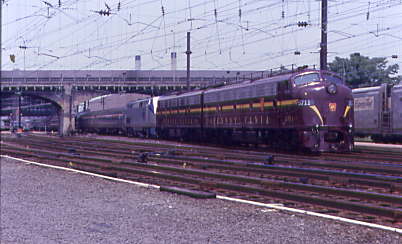
Roster shots of the E8s. Happy with my success, I exited as quickly as I came in since someone else followed my lead.
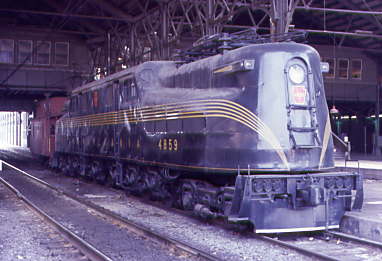
Conrail GG-1 4859, nee Pennsylvania Railroad 4859, built by General Electric in 1937; and Pennsylvania Railroad caboose 980016, built by the railroad in 1920, on display at the station. I returned to the nice cool train as the temperature and humidity was in the high nineties. About twenty-five minutes before we were to leave, the sky opened up which forced everyone back into the train as a major thunderstorm with lightning to behold rumbled through town. We pulled forward so all the first class cars would be under the station shed.